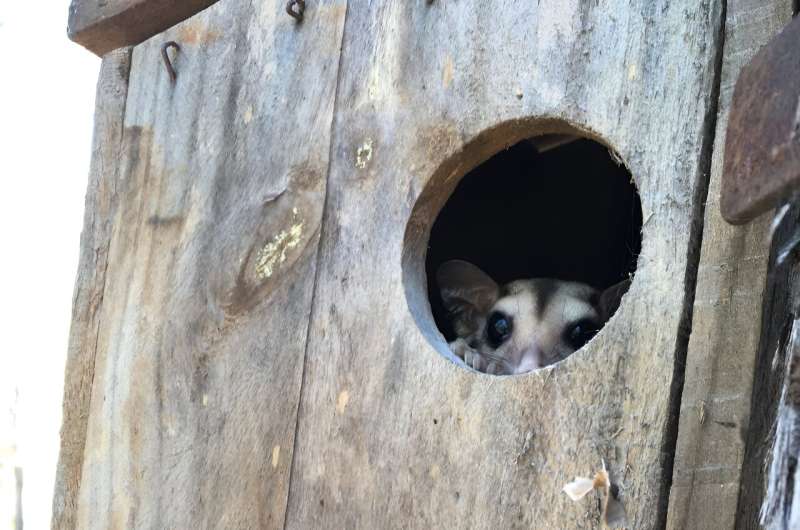This article has been reviewed according to Science X's editorial process and policies. Editors have highlighted the following attributes while ensuring the content's credibility:
fact-checked
peer-reviewed publication
trusted source
proofread
Tree hidey-holes key to helping slow declines of small mammals

A decline of natural tree hollows is forcing arboreal mammal numbers to fall, according to a new study exploring why these species are disappearing in Northern Australia.
The study led by Charles Darwin University's (CDU) Research Institute for the Environment and Livelihoods (RIEL) investigated whether the number of tree hollows in Northern Australian tropical savanna are contributing to the decline of arboreal mammals, or animals that live in trees.
The study, "Nestbox use indicates declining arboreal mammals in an Australian savanna may be limited by tree hollow availability" was published in the journal Forest Ecology and Management.
Researchers surveyed 187 nestboxes placed across the Cobourg Peninsula within Garig Gunak Barlu National Park during the three-year study period. They found that in total 67% of nestboxes were used by mammals at least once.
Of the 119 nestboxes monitored by camera, 82% were used by mammals: 56% by the brush-tailed rabbit-rat, 44% by the savanna glider, 41% by the black-footed tree-rat, 15% by the fawn antechinus, and 4% by the northern brushtail possum.
Lead author and RIEL Adjunct Research Associate Dr. Leigh-Ann Woolley, who is also the Northern Australia Biocultural Conservation Manager for WWF-Australia, said the high number of mammals using the nestboxes was unexpected.
"We were skeptical that mammals would use the nestboxes we deployed at all, never mind that their nestbox use would be strongly associated with tree hollow density at a site," Dr. Woolley said.
"This showed that these declining arboreal mammals were searching for and using new dens where natural hollows were reduced at a local site.
"Among the multitude of threats interacting to cause the decline of these species, such as inappropriate fire, introduced ungulates, and feral predators, habitat quality should not be disregarded when managing threats to improve outcomes for these mammals."
Arboreal mammals play a crucial role in savanna ecosystems by dispersing seeds, pollinating plants, and have adapted to take advantage of unique seasonal savanna features such as frequent fires, flowering and fruiting plants, grass seeds, insects, eucalyptus sap, among many others.
Dr. Woolley said to slow declines and stop extinctions of hollow-using animals in northern Australia, protecting large savanna eucalypts as ecosystem assets would be critical.
"Good quality habitat with ample tree hollows for denning and nesting, as well as high quality and abundant food sources, will buffer against other serious threats to these animals," she said.
"For example, arboreal mammals don't need to spend as much time on the ground traveling between trees if tree density is higher. Less time on the ground means they are less vulnerable to predation by feral cats.
"Short-term strategies to support arboreal mammals include halting land clearing and protecting large, hollow-bearing savanna eucalypts. Longer-term strategies to optimize habitat include fire regimes dominated by cooler, less frequent fires to ensure large trees are retained, tree hollow densities are increased, and food resources such as fruiting shrubs are enhanced."
The study was conducted alongside the Department of Biodiversity, Conservation and Attractions in Western Australia, the Department of Environment, Parks and Water Security in the Northern Territory, and the University of KwaZulu-Natal in South Africa.
More information: Leigh-Ann Woolley et al, Nestbox use indicates declining arboreal mammals in an Australian savanna may be limited by tree hollow availability, Forest Ecology and Management (2024). DOI: 10.1016/j.foreco.2024.121915
Journal information: Forest Ecology and Management
Provided by Charles Darwin University



















